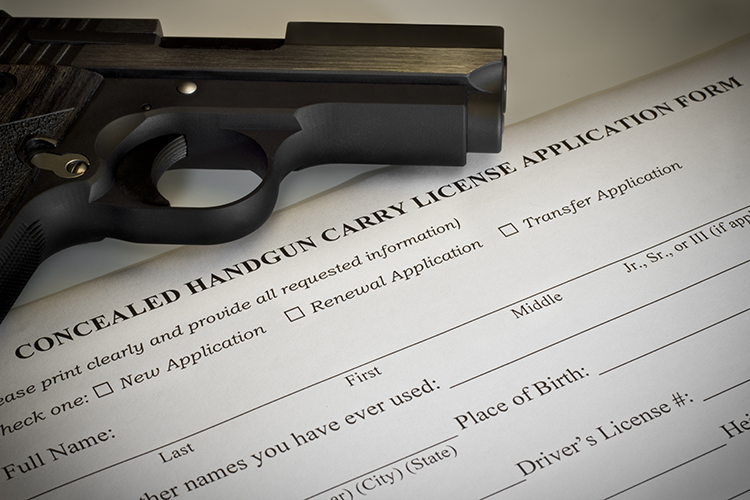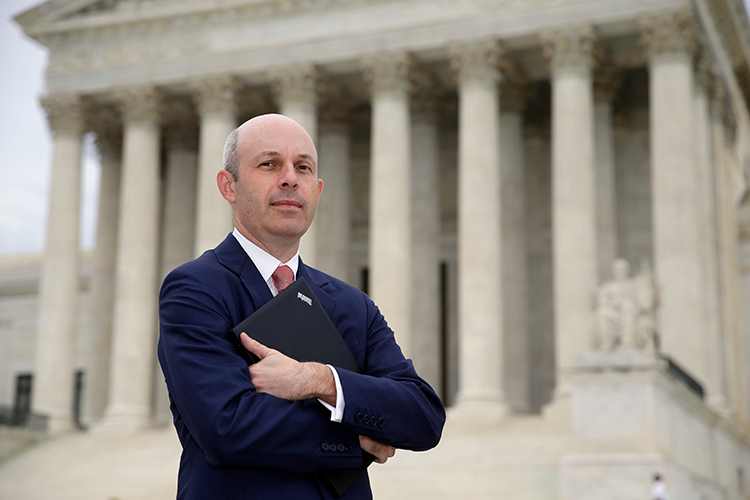Gun laws aren't 'trapped in amber,' SCOTUS says while upholding restraining-order gun ban

The U.S. Supreme Court on Friday upheld a federal law banning gun possession by those who are subject to domestic-violence restraining orders. (Image from Shutterstock)
The U.S. Supreme Court on Friday upheld a federal law banning gun possession by those who are subject to domestic-violence restraining orders.
The law is consistent with the Second Amendment, the Supreme Court said in an opinion by Chief Justice John Roberts.
The only dissenter was Justice Clarence Thomas, who argued that the majority had failed to follow his clear directive on how to analyze gun laws in a prior Second Amendment case.
The law at issue bans possession of a firearm by anyone who is deemed by a judge to be a “credible threat” to an intimate partner or to that person’s child after notice and a court hearing.
“Since the founding, our nation’s firearm laws have included provisions preventing individuals who threaten physical harm to others from misusing firearms,” Roberts wrote in United States v. Rahimi. The federal law “fits comfortably within this tradition.”
Supreme Court precedents on gun rights “were not meant to suggest a law trapped in amber,” Roberts said.
This Week in Supreme Court News
• ‘Storm clouds loom ahead’ after Supreme Court dismisses abortion dispute, Justice Jackson says• Supreme Court blocks controversial Purdue Pharma opioid settlement
• SCOTUS blocks EPA’s ‘downwind’ air-quality initiative
• SEC defendants are entitled to jury trials, SCOTUS rules in case with ‘broad ramifications’
• Supreme Court would allow emergency abortions in Idaho, Bloomberg reports
• 5th Circuit ‘glossed over complexities,’ Supreme Court says in refusing to curb US social media contacts
• Ban on gender-affirming care for transgender minors will be reviewed by Supreme Court
• Gun laws aren’t ‘trapped in amber,’ SCOTUS says while upholding restraining-order gun ban
“The Second Amendment permits more than just those regulations identical to ones that could be found in 1791. Holding otherwise would be as mistaken as applying the protections of the right only to muskets and sabers.”
Six justices wrote or joined concurrences that discussed originalism and approaches to constitutional interpretation.
In his dissent, Thomas asserted that “not a single historical regulation justifies the statute.”
Thomas argued that the majority was not following the approach in his June 2022 majority decision in New York State Rifle & Pistol Association Inc. v. Bruen.
In Bruen, Thomas said gun laws are permissible only if they are “consistent with the nation’s historical tradition of firearm regulation.”
Tom “T.M.” Wolf, a Supreme Court expert at the Brennan Center for Justice at the New York University School of Law, offered a “first take” on the Rahimi decision in a post on X, formerly known as Twitter.
“The court is trying to climb out of the hole it dug with Bruen,” Wolf wrote.
In a prior post, Wolf said the Supreme Court’s conservative bloc “has split between originalism and an alternative approach that looks to the whole of American history.”
In his concurrence in Rahimi, Justice Brett Kavanaugh outlined a more expansive approach to historical interpretation.
Kavanaugh said vague constitutional text should be interpreted using precedent and history, looking at laws, practices and understandings from before and after ratification.
“The collective understanding of Americans who, over time, have interpreted and applied the broadly worded constitutional text can provide good guidance for a judge who is trying to interpret that same text decades or centuries later,” Kavanaugh said.
The practices after ratification are sometimes referred to as “tradition,” Kavanaugh said.
He quoted a prior opinion of originalist Justice Antonin Scalia, who wrote that when constitutional text is unclear, “the widespread and long-accepted practices of the American people are the best indication of what fundamental beliefs it was intended to enshrine.”
Kavanaugh also said courts must respect precedent, “while at the same time recognizing that precedent on occasion may appropriately be overturned.”
In his concurrence, Justice Neil Gorsuch suggested that the gun law could face further challenges in the future. The majority upheld a facial challenge to the law but left open whether the law could violate the Second Amendment in some circumstances, he wrote.
The Supreme Court ruled in the case Zackey Rahimi, an alleged drug dealer accused of grabbing his girlfriend by the wrists during an argument in 2019 in Arlington, Texas, and knocking her to the ground. He then allegedly dragged her into his car, causing her to hit her head on the dashboard. A judge issued a restraining order in February 2020.
Zahimi was arrested after he was accused of participating in five shootings, none of which resulted in injuries.
Hat tip to SCOTUSblog, which had early coverage of the decision.
The case is United States v. Rahimi.
See also:
Chemerinsky: Supreme Court once again will consider the scope of gun rights
Chemerinsky: Expect another momentous year at the Supreme Court



